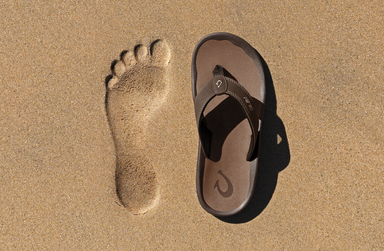Anywhere Aloha
OluKai
Nov 13, 2014
Whales in the Wake—The Whale Sharks of Hawaii
[caption id="attachment_1464043" align="aligncenter" width="604"]

©istockphoto/crisod[/caption]
A Gentle Giant
Big, blotched, and beautiful, the whale shark (
Rhincodon typus) is the world’s largest fish. And reaching lengths of nearly forty-feet long and weighing, in excess of twenty-tons, it’s rightfully so. Coincidentally, the second largest fish species is also a filter-feeding Jaws of sorts, the basking shark. But at just a “mere” twenty-five feet on average, its feeding gape is dwarfed by that of the whale sharks.
Nomadic by nature, whale sharks occupy the tropical waters of the world, encompassing the Pacific, Atlantic, and Indian oceans. But despite their gypsy-inclined tendencies, they do exhibit what marine biologist called “residency migratory habits.” And, quite simply, patterns are temporal-sensitive times where otherwise migratory animals will reside in one area for an extended period—sexual reproduction and feeding events are often the catalyst for such lengthy residencies. Here’s an allusion that may ring-clear to the masses: Celebrities are often portrayed by our tabloids and social media outlets as always on-the-go, happily living out their days at cruising altitude. But occasionally, such a celebrity will take-up residency at a ritzy Las Vegas casino: Cher, Britney Spears, Jennifer Lopez, Carlos Santana... the list goes on. Got it, get it?
Hawaii offers-up quite the ecological gold-mind for these open-ocean dwellers. The plankton-rich waters off the coast of Hawaii allow these animals to reside comfortably during their stay. And what’s interesting enough is that the animals that reside in those waters appear to be mature or adolescent sharks; no newly-born animals have been recorded. What does this imply, exactly? Well, this factoid may very well represent a pivotal-point in a whale shark's reproductive cycle. These residential animals are more than likely taking full-advantage of the copious amounts of sustenance to support the matting patterns that take place in the open ocean. A whale shark mating’s never been recorded in the shallows of our world’s oceans—but they’re obviously reproducing. And viviparously, mind. Most sharks produce oviparously via fruited eggs that are known as “mermaid purses,” later hatching into miniature versions of their parental units. Female whale sharks, on the other hand, produce up-to a thousand unfertilized eggs that will later be internally fertilized by a suitable male; granted, not every egg will be fertilized. Once gestation has ran its course, the female will give birth to the viable young, populating the nomadic open oceans.
Big Shark, Big Business
Docile and curious by nature, whale sharks are a treat to see on a whale-watching odyssey. In the island state of Hawaii, most animals can be seen frequenting the channels between Lanai and Molokai, as well as the Penguin Banks. Some animals will often approach a sea-going vessel to “greet” its sea goers, providing an unforgettable experience. When was the last time you were nonchalantly approached by a thirty-seven foot fish that, if it could communicate with our species, would utter, “Oh, hey guys. What’s with the legs?” And being that whale watching often nets an annual revenue of nine-million dollars for Hawaii, it’s a big business.
Whale sharks are considered a “Vulnerable” (VU) species by the IUCN Red list. And sadly, many whale sharks meet their end at blades of a passing boat propeller. Be mindful, be present—invest in a propeller guard. “Big, blotched, and beautiful [and thriving],” let’s try to keep it that way.
―IUCN Red List Contributor and green journalist, Matthew Charnock
 ©istockphoto/crisod[/caption]
A Gentle Giant
Big, blotched, and beautiful, the whale shark (Rhincodon typus) is the world’s largest fish. And reaching lengths of nearly forty-feet long and weighing, in excess of twenty-tons, it’s rightfully so. Coincidentally, the second largest fish species is also a filter-feeding Jaws of sorts, the basking shark. But at just a “mere” twenty-five feet on average, its feeding gape is dwarfed by that of the whale sharks.
Nomadic by nature, whale sharks occupy the tropical waters of the world, encompassing the Pacific, Atlantic, and Indian oceans. But despite their gypsy-inclined tendencies, they do exhibit what marine biologist called “residency migratory habits.” And, quite simply, patterns are temporal-sensitive times where otherwise migratory animals will reside in one area for an extended period—sexual reproduction and feeding events are often the catalyst for such lengthy residencies. Here’s an allusion that may ring-clear to the masses: Celebrities are often portrayed by our tabloids and social media outlets as always on-the-go, happily living out their days at cruising altitude. But occasionally, such a celebrity will take-up residency at a ritzy Las Vegas casino: Cher, Britney Spears, Jennifer Lopez, Carlos Santana... the list goes on. Got it, get it?
Hawaii offers-up quite the ecological gold-mind for these open-ocean dwellers. The plankton-rich waters off the coast of Hawaii allow these animals to reside comfortably during their stay. And what’s interesting enough is that the animals that reside in those waters appear to be mature or adolescent sharks; no newly-born animals have been recorded. What does this imply, exactly? Well, this factoid may very well represent a pivotal-point in a whale shark's reproductive cycle. These residential animals are more than likely taking full-advantage of the copious amounts of sustenance to support the matting patterns that take place in the open ocean. A whale shark mating’s never been recorded in the shallows of our world’s oceans—but they’re obviously reproducing. And viviparously, mind. Most sharks produce oviparously via fruited eggs that are known as “mermaid purses,” later hatching into miniature versions of their parental units. Female whale sharks, on the other hand, produce up-to a thousand unfertilized eggs that will later be internally fertilized by a suitable male; granted, not every egg will be fertilized. Once gestation has ran its course, the female will give birth to the viable young, populating the nomadic open oceans.
Big Shark, Big Business
Docile and curious by nature, whale sharks are a treat to see on a whale-watching odyssey. In the island state of Hawaii, most animals can be seen frequenting the channels between Lanai and Molokai, as well as the Penguin Banks. Some animals will often approach a sea-going vessel to “greet” its sea goers, providing an unforgettable experience. When was the last time you were nonchalantly approached by a thirty-seven foot fish that, if it could communicate with our species, would utter, “Oh, hey guys. What’s with the legs?” And being that whale watching often nets an annual revenue of nine-million dollars for Hawaii, it’s a big business.
Whale sharks are considered a “Vulnerable” (VU) species by the IUCN Red list. And sadly, many whale sharks meet their end at blades of a passing boat propeller. Be mindful, be present—invest in a propeller guard. “Big, blotched, and beautiful [and thriving],” let’s try to keep it that way.
―IUCN Red List Contributor and green journalist, Matthew Charnock
©istockphoto/crisod[/caption]
A Gentle Giant
Big, blotched, and beautiful, the whale shark (Rhincodon typus) is the world’s largest fish. And reaching lengths of nearly forty-feet long and weighing, in excess of twenty-tons, it’s rightfully so. Coincidentally, the second largest fish species is also a filter-feeding Jaws of sorts, the basking shark. But at just a “mere” twenty-five feet on average, its feeding gape is dwarfed by that of the whale sharks.
Nomadic by nature, whale sharks occupy the tropical waters of the world, encompassing the Pacific, Atlantic, and Indian oceans. But despite their gypsy-inclined tendencies, they do exhibit what marine biologist called “residency migratory habits.” And, quite simply, patterns are temporal-sensitive times where otherwise migratory animals will reside in one area for an extended period—sexual reproduction and feeding events are often the catalyst for such lengthy residencies. Here’s an allusion that may ring-clear to the masses: Celebrities are often portrayed by our tabloids and social media outlets as always on-the-go, happily living out their days at cruising altitude. But occasionally, such a celebrity will take-up residency at a ritzy Las Vegas casino: Cher, Britney Spears, Jennifer Lopez, Carlos Santana... the list goes on. Got it, get it?
Hawaii offers-up quite the ecological gold-mind for these open-ocean dwellers. The plankton-rich waters off the coast of Hawaii allow these animals to reside comfortably during their stay. And what’s interesting enough is that the animals that reside in those waters appear to be mature or adolescent sharks; no newly-born animals have been recorded. What does this imply, exactly? Well, this factoid may very well represent a pivotal-point in a whale shark's reproductive cycle. These residential animals are more than likely taking full-advantage of the copious amounts of sustenance to support the matting patterns that take place in the open ocean. A whale shark mating’s never been recorded in the shallows of our world’s oceans—but they’re obviously reproducing. And viviparously, mind. Most sharks produce oviparously via fruited eggs that are known as “mermaid purses,” later hatching into miniature versions of their parental units. Female whale sharks, on the other hand, produce up-to a thousand unfertilized eggs that will later be internally fertilized by a suitable male; granted, not every egg will be fertilized. Once gestation has ran its course, the female will give birth to the viable young, populating the nomadic open oceans.
Big Shark, Big Business
Docile and curious by nature, whale sharks are a treat to see on a whale-watching odyssey. In the island state of Hawaii, most animals can be seen frequenting the channels between Lanai and Molokai, as well as the Penguin Banks. Some animals will often approach a sea-going vessel to “greet” its sea goers, providing an unforgettable experience. When was the last time you were nonchalantly approached by a thirty-seven foot fish that, if it could communicate with our species, would utter, “Oh, hey guys. What’s with the legs?” And being that whale watching often nets an annual revenue of nine-million dollars for Hawaii, it’s a big business.
Whale sharks are considered a “Vulnerable” (VU) species by the IUCN Red list. And sadly, many whale sharks meet their end at blades of a passing boat propeller. Be mindful, be present—invest in a propeller guard. “Big, blotched, and beautiful [and thriving],” let’s try to keep it that way.
―IUCN Red List Contributor and green journalist, Matthew Charnock





